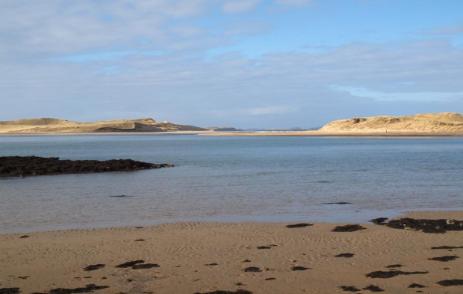
Bayness Bay
Looking across the wide stretches of sand or mud-flat at low tide in a shallow bay or estuary, it’s hard to believe that these are some of Nature’s richest feeding grounds. But when you see the huge flocks of birds that move in to feast in these areas, you can get some measure of their hidden bounty. Under one square metre of mud, there can be tens of thousands of tasty food items.
The secret of all this fertility lies in the silt which is constantly being washed down by the rivers, carrying minerals and organic matter which support the hordes of various worms and shellfish and crustaceans. Some of the best spots in Donegal for watching feeding flocks in action are around Donegal Bay, Ballyness Bay at Falcarragh, and Trawbreaga Bay on Inishowen. And the Swilly Estuary ranks as one of the top sites in the whole country.
The constant ebb and flow of the tide means that this is an ever-changing scene and the birds are always on the move. But they’re not just rushing around to grab what they can. This is a highly-organised gathering, and every species has its own tricks and techniques to make sure it gets its share. Most obvious are the different lengths and designs of their beaks, which means that they can probe to different depths and specialise in different prey items. The Curlew’s huge curved beak, up to 15 cm long, can reach deeper than anyone else. Oystercatchers have big heavy beaks which can wrench limpets off rocks and smash cockle and mussel shells. Lapwings and Plovers have small beaks designed for surface picking, and the little Dunlin specialises in a rapid “stitching” technique, going along like a sewing machine.
All the waders which feed by probing have sensitive beak-tips which enable them to find their prey by touch, so they can feed in complete darkness when low tide happens during the night. Turnstones mostly feed along the rocky shoreline, flipping over stones to get at items underneath. They can push back mats of seaweed, just like rolling up a carpet, and a few of them often join together to shift something too big for one.
This is the time of year when flocks of wintering wild geese and Whooper swans are beginning to pour in from their breeding grounds in the far north. The one that you’re most likely to see around coastal estuaries and mudflats is the small black-and-white Brent Goose, which is much more relaxed and approachable than the others. Ireland has its own special race or sub-species of Brent Goose, the Light-bellied, which travels all the way to the far north of Canada every summer to breed – the longest migration route of any of our wildfowl.
Barnacle Geese are extremely wild and wary, and spend a lot of time around offshore islands, but there’s a flock that appears fairly regularly around Trawbreaga Bay. Greylag Geese can be seen around the Swilly, as well as flocks of feral Canada Geese which are not native to Ireland but have originally escaped from wildfowl collections. White-fronted Geese are found on open slobland and marshy areas, and are often seen at Inch and around the New Lake at Dunfanaghy. The best way to get good views of the goose flocks is to stay inside your car and park at the nearest possible viewing point. The car acts as a mobile hide. The haunting calls of wild geese are some of the classic soundtracks of winter.
Two species of seal are found in Ireland and both are fairly frequent around Donegal. The one most typical of estuaries and sheltered bays is the Common or Harbour Seal, often seen relaxing on sandbanks at low tide. You can get good views of them around Donegal Bay. The Grey Seal is a larger animal with a longer down-curved nose, and is more likely to turn up around exposed rocky coasts. One reliable spot for viewing them is at Glasagh on the north of Fanad. Most of our Grey Seals breed in Scotland, though there are a few small breeding colonies on remote corners of the Donegal coast. The pups are born in autumn and remain on land until weaned at three weeks old. Common Seal pups, which are born in summer, can take to the water straight away and feed from their mothers at sea.
Four to Find this Month:Hazel Nuts: These are a rich source of protein and fat for many wild creatures, including mice, squirrels, and members of the crow family. A Great Tit will hammer for up to fifteen minutes to break through the shell and extract the kernel. |